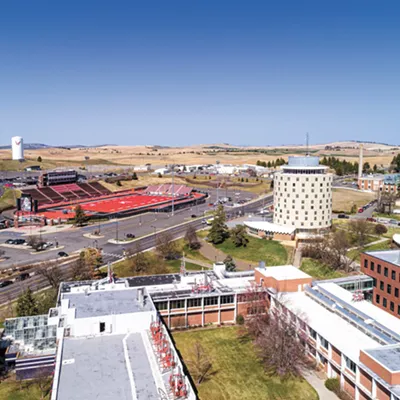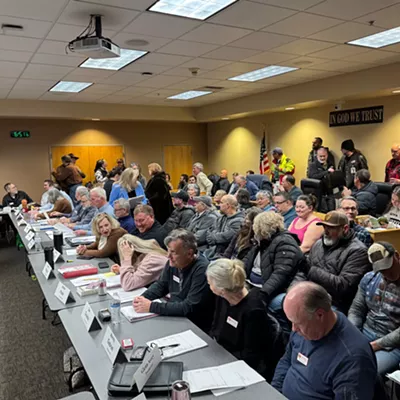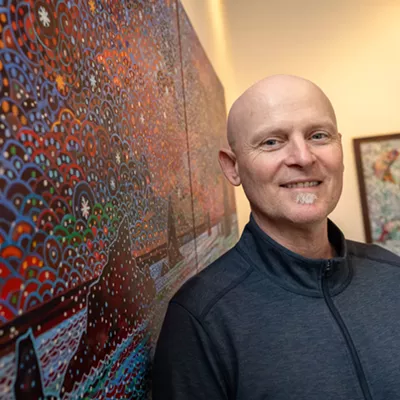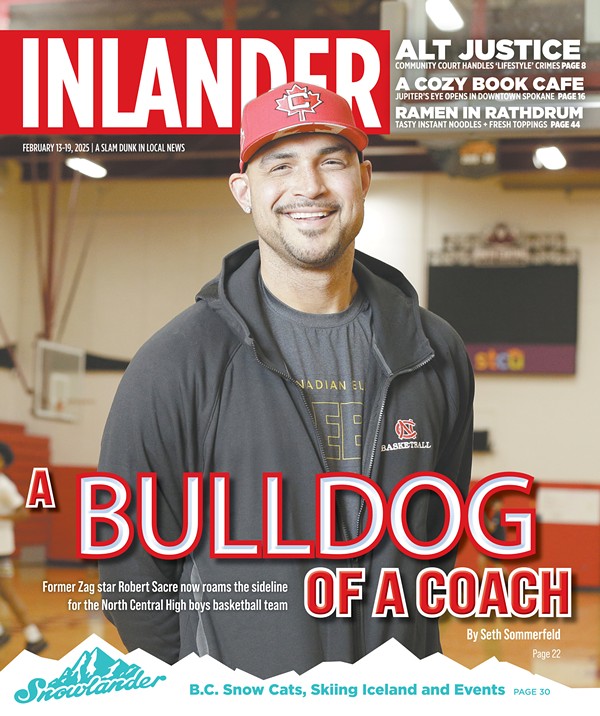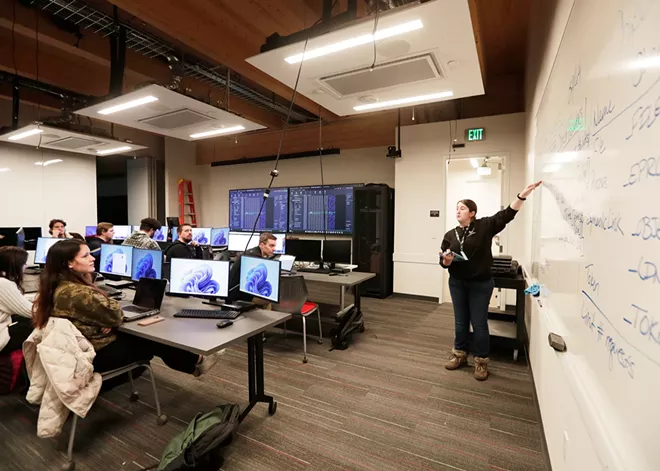
More than a year ago, Eastern Washington University's Board of Trustees tasked University President Shari McMahan with defining the college's identity. In response, she created an identity and marketing work group composed of faculty and staff to delve into the question.
After eight months of work, the group recommended that the university become a polytechnic.
"For me, we just named what we already do. Our job is to help students level up their knowledge and hopefully get a job," says Travis Masingale, a professor in the design department and a member of the president's marketing work group.
"When someone first brought up polytechnic, I thought, 'Probably not,' though I found after more research, that's exactly what we do," he continues. "What we call it is not so much the problem, but this offers us a way forward."
Although the term polytechnic is generally thought of as a school focusing on science, technology, engineering and math, or STEM — and is defined as such by Merriam-Webster — administrators believe the term fits.
"There is no formal definition of polytechnic, nor any set requirements for becoming a polytechnic university," a statement on Eastern's website says. "EWU will be able to define polytechnic in our own way, which will include an emphasis on applied learning. We want all programs to feature career-connected learning whether that is research, internships, teacher training, etc."
One university that the marketing work group looked at for inspiration was California State Polytechnic University, Humboldt, which became California's third polytechnic school in 2022. There, too, the intent was to focus on hands-on opportunities for students. Unlike Eastern though, the California polytechnic received more than $450 million in one-time funding from the state's Legislature to help with that change, which included adding new programs.
In May, Eastern's Board of Trustees approved the work group's recommendation, marking the start of a new era as "Eastern Washington University: The Region's Polytechnic." With that decision, Eastern became the only polytechnic in Washington state.
"This is really something to differentiate ourselves from the rest of the pack," Masingale says. "Nobody knows what a regional comprehensive university is. No one would know what we're talking about if we tried to market that."
WHAT'S GETTING CUT?
Amid this major marketing shift, Eastern is still working to discontinue or modify some of the university's services and academic programs to save money.
This effort, called the "strategic resource allocation" process, began two years ago when two committees were created to rank everything Eastern offers into five categories: invest, maintain, streamline, transform or disinvest. Last year, that process was completed when the committees submitted reports recommending cuts to 175 of Eastern's academic programs.
Now, Eastern has progressed to a multiyear implementation stage.
"The changes underway are not about diminishing opportunities but about sharpening our focus and creating pathways that serve our students and the community," Provost Jonathan Anderson tells the Inlander. "While some programs are being downsized or may be phased out, it is equally important to highlight the many investments we are making to enhance existing programs and launch new, innovative ones."
An action plan released on Sept. 26 by EWU leaders, including Anderson, four vice presidents and the athletics director, outlines how certain university services will be affected.
For things like dining services and the handful of fast food spots on campus, which were placed in the "disinvest" category, Eastern plans to outsource them to third-party providers. But for football, which has been losing money for years and was placed in the "transform" category, administrators plan to pump more money into the program in hopes of creating additional revenue.
The action plan states the school will work "with ALSC Architects to develop more refined estimates for stadium renovation and construction that, in partnership with the EWU Foundation and the comprehensive campaign, would generate additional revenue for EWU Athletics Department and increase stadium usability for campus and external events."
During the strategic resource allocation process, Eastern's student-led newspaper, the Easterner, was placed in the transformation category, with the university services committee noting that "student journalism is a vital service for the university and The Easterner needs to continue to serve our community."
The action plan, however, advocates for the "transition from The Easterner to strategic partnerships with local news outlets like the Spokesman-Review or Inlander." (The school has not discussed such a plan with the Inlander.)
For those curious about how other university services might be impacted, the 140-page action plan can be found at inside.ewu.edu/sra.
The path ahead for academic programs is less straightforward.
Currently, each department is working to review the provost's recommendations for their programs. Those that may be revised must submit their planned revisions to the provost, who will review them further.
Faculty Senate President Carlos Castillo-Garsow says the "program review and discontinuance" process will take the rest of the school year.
The 20 programs currently on the chopping block — including all five physics majors and minors, a few foreign language minors, and education programs in Eastern's College of Professional Programs — must make their case to the Faculty Senate by Dec. 9, Castillo-Garsow says.
"The [Faculty] Senate ratifies those recommendations, and that can either be to keep the program as is, transform it in some way or discontinue it," he explains. "It's important to remember we are a recommending body and the decision that we make isn't binding."
The Faculty Senate will then submit recommendations to President McMahan. Castillo-Garsow hopes to do so by the end of January. Another recommendation on those academic programs will come to McMahan's office from the provost. Anderson says his recommendation will be sent after reviewing the Faculty Senate's report.
"The Faculty Senate's recommendations, expected by the end of January, will be an essential part of the shared governance process, guiding the next steps," Anderson says via email. "This ensures that decisions are influenced and informed by our shared governance process."
After weighing those sets of recommendations, she'll draft her own opinion — which still isn't a binding decision — and send it to the Board of Trustees, which gets the final say.
Though the timeline is still unclear, a Sept. 26 letter from McMahan states that she hopes the Board of Trustees will "take final action on discontinuance recommendations in February 2025," more than a year after the strategic resource allocation reports were released.
"It's a long process by design," Castillo-Garsow says. "The purpose of having these various layers is to make sure there are eyes on this, because discontinuing a program is a huge deal."

NEW NAME, SAME FACE
Steve Simmons has been deeply connected with Eastern for the last 55 years and says he feels that the recent rebrand aligns with how he's typically seen the university.
"To me, [polytechnic] just means they're back in tune with their historic nature," he says. "We've always been dedicated to applied learning and career prep here at Eastern."
Simmons, now an emeritus professor, began teaching math at the university in 1969. Then in 1984, he helped found Eastern's computer science department, now located in the Catalyst Building and which recently celebrated its 40th anniversary.
The small computer science department was housed within the mathematics department until 1990, when the department became its own entity, led by Simmons. There he worked on communications, which he says helped him drift into the English department at one point in his career.
In all three of the departments he worked in, Simmons says he saw some form of applied, experiential learning, which is part of why he's so supportive of the polytechnic title as Eastern has defined it.
"Eastern was in trouble with not having an identity, and if you know anything about higher education we really need an identity," Simmons says. "The polytechnic title focuses in on all the good work we've been doing for years, especially in high-demand fields like computer science and cybersecurity."
Stu Steiner, an associate professor in computer science and the director of Eastern's Cybersecurity Institute, agrees with Simmons, adding that the polytechnic title supports high-demand jobs such as those in the cybersecurity sector. After the rebrand in May, Steiner saw a rapid increase in interest for the program. At the end of the 2023-24 school year in June, he says there were only 26 declared majors. Now, there are 85 students seeking a degree in cybersecurity at Eastern.
Steiner doesn't see that slowing down anytime soon either, especially with how much work his students can do locally.
"We're going out to small businesses in Spokane, and really, across the state, doing cybersecurity assessments for these places," Steiner explains. "We always give them tools to improve their cybersecurity hygiene and because ransomware is always changing to do the most damage possible."
That experience, he says, is at the core of what a polytechnic should be.
UNNECESSARY CHANGES?
Some faculty believe that the new branding was an unnecessary and confusing change.
"We've consistently heard that we're going to define what a polytechnic means, but I don't understand how that's a good marketing strategy, using a word that means one thing but saying it's something else," says David Syphers, associate physics professor. "If you're selling a bicycle and say it's a car, people will know."
Though Syphers agrees that applied learning can be helpful for many of the programs at Eastern, he was confused by the rebrand because the university was already providing applied learning opportunities. This change, he argues, negatively impacts programs that can't be taught in an applied or hands-on way.
"We have students who want to be theoretical physicists, which is not applied at all," he says.
One might think that physics, the science of matter, motion and energy, is a perfect fit for a polytechnic school, but at Eastern every single physics program is at risk of being cut. While it's still not clear if the programs will actually be axed, Syphers worries about what might happen to the five-person department.
"Most of what we teach are service courses to other programs, like chemistry and biology. We serve a lot of the larger majors on campus," he explains.
Syphers and the other physics professors would likely not lose their jobs, he says. Instead, they'd be teaching 100-level physics courses as precursors for other majors.
"I'll still be tenured, but, I wouldn't get to advise students, and I wouldn't teach any [higher-level] courses," he says. "I think we should have remained a regional comprehensive instead of just announcing this rebrand at a meeting."
Judy Rohrer, the director of Gender, Women's and Sexuality Studies, agrees. She says the change was unnecessary and even damaging to enrollment, as she argues students seeking a liberal arts education might not apply to a polytechnic school.
"Applied learning is absolutely what many programs engage in, but that's not the same as being a polytechnic, those are different things, so [concerned faculty] kept trying to have that conversation, but those conversations never seem to go anywhere," she says. "Whatever you say, polytechnic doesn't signal a strong liberal arts program, it supports tech and tech is not people-centered. Those of us in the social sciences and humanities were worried about what that means for our programs."
She feels that if there would have been more collaboration between faculty and administration in the rebranding, they could have figured out how to showcase the college without adding a self-defined descriptor.
"We could actually be lifting our people-centered programs up as a beacon in the region to attract students," she says. "Being a polytechnic just doesn't make sense to a lot of our students." ♦
Editor's Note: This story was updated on Dec. 2 to more accurately describe the courses David Syphers will no longer teach, which are higher-level classes.



